Philodendrons are plants of the Aroid family, existing in the form of grass, vines and bushes. Their homeland is Brazil, America and the Antilles. Philodendron is listed on NASA's list of plants that cleanse the air most efficiently. The flower got its name for its special love for trees. In the natural habitat, he uses them as a support to get closer to the light of the sun.
The plant is characterized by a wide species diversity. The species differ among themselves not only externally, but also in preferences to environmental conditions. Therefore, different species require some care. You can verify the diversity of the philodendron by looking at its types with names and photos, and choose the most suitable for yourself.
Content
Philodendron characteristics and species names with description
Philodendron is an evergreen perennial. Some of its species are capable of flowering. The inflorescence consists of a cob and bedspread, characteristic of all Aroid ones. Plant flowers do not represent decorative value. Moreover, at home they bloom deformed.
The root system is complex. It consists of underground and aboveground roots. Elevated, in turn, are divided into 2 types. With the help of some, the flower is attached to the supports, while others extract additional nutrients.
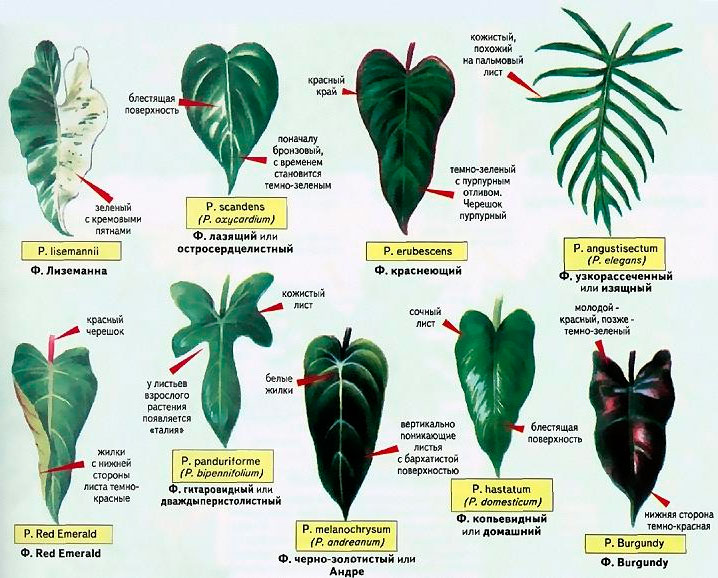
The stems are fleshy, climbing. At the base, they are usually lignified. The leaves are large, leathery. Color and shape varies depending on species. In appearance they are dense, but in fact they are easily injured.
Climbing
Climbing Philodendron is a variety of ivy species. It features a long sophisticated stalk reaching more than 3 meters. The leaves are heart-shaped with a very pointed tip. The surface of the plates is glossy. In young leaves, it is bronze, but with age it becomes bright green. Leaves are attached to elongated petioles.
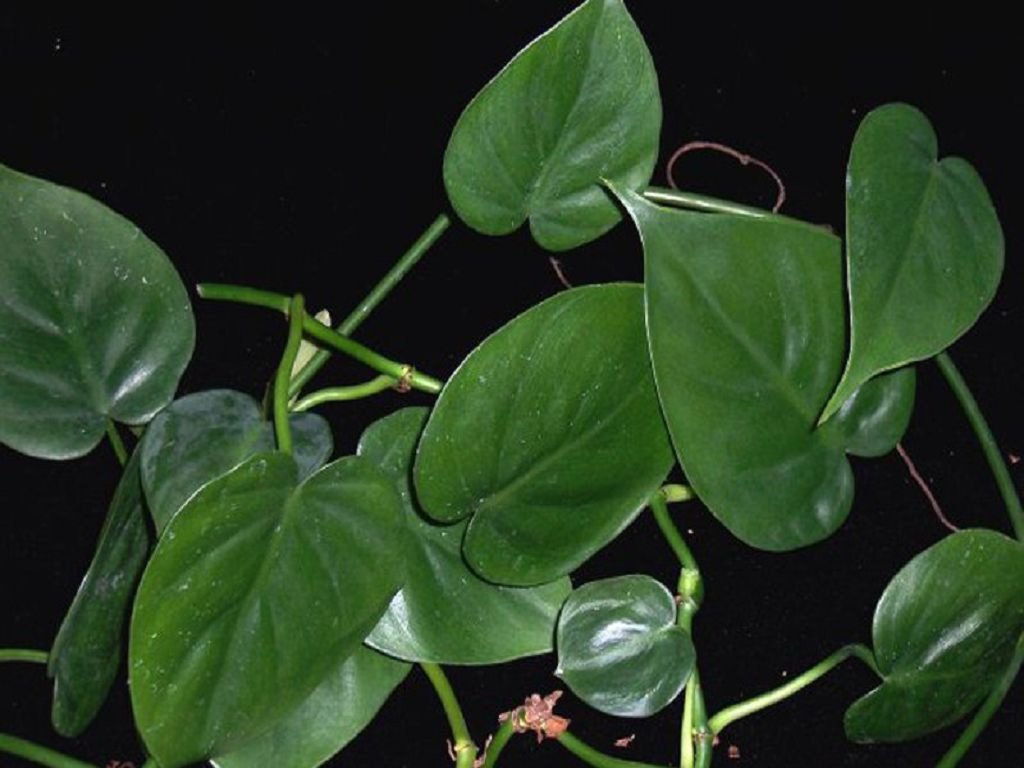
This species has become the mother of many hybrids. Many varieties are distinguished by a metallic sheen on the surface of the leaves or a brownish tint. Climbing philodendrons are considered to be flowering, but at home it is impossible to achieve their flowering.
Sello
This species is also known as Dicotyledon-bifurcated and Bicoperid philodendron. In young plants, the leaves are whole and heart-shaped, painted with a delicate light green color. As they grow older, the plates change, acquiring a cirrus-dissected shape and a dark green color.
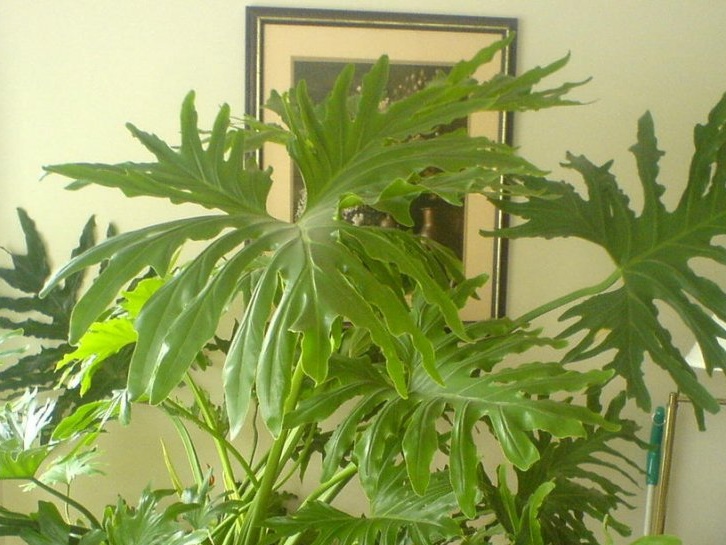
Sello is a flowering species. During the flowering period, the plant is able in a special way to increase the temperature of the air around it. From the flowers of Sello comes a pleasant sweet aroma. In some countries, the fruits of this species are used for food, and juice from the leaves is used for medicinal purposes.
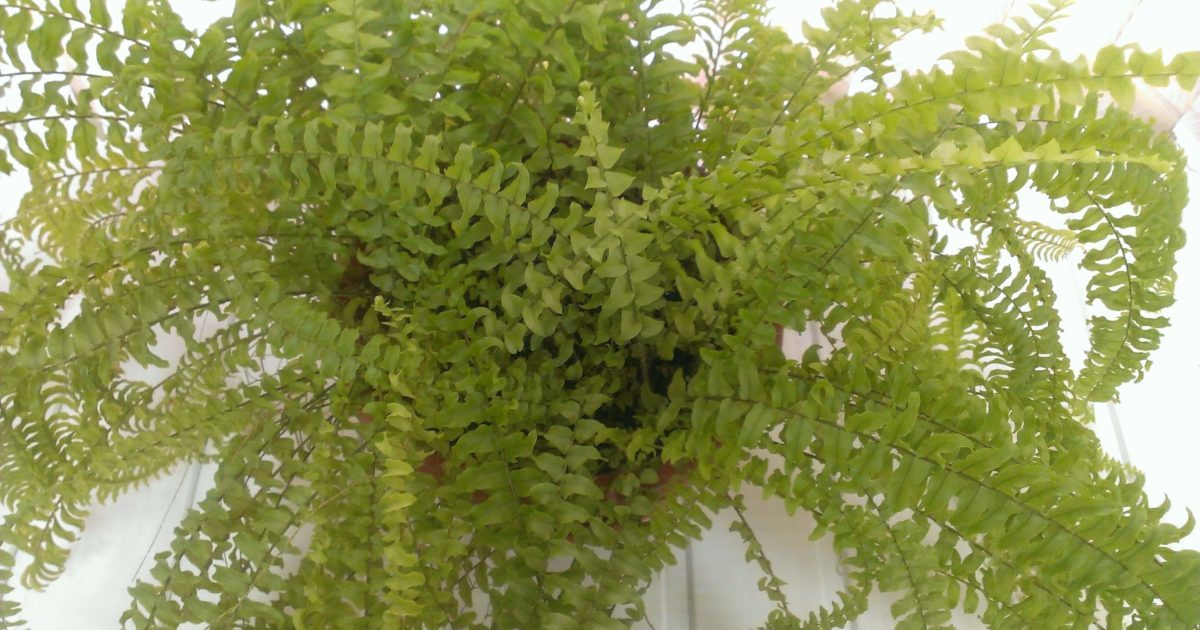 You may be interested in:
You may be interested in:Scandens brazil
Scandens Brazil is a type of Climbing Philodendron. It differs from the source only in leaves.
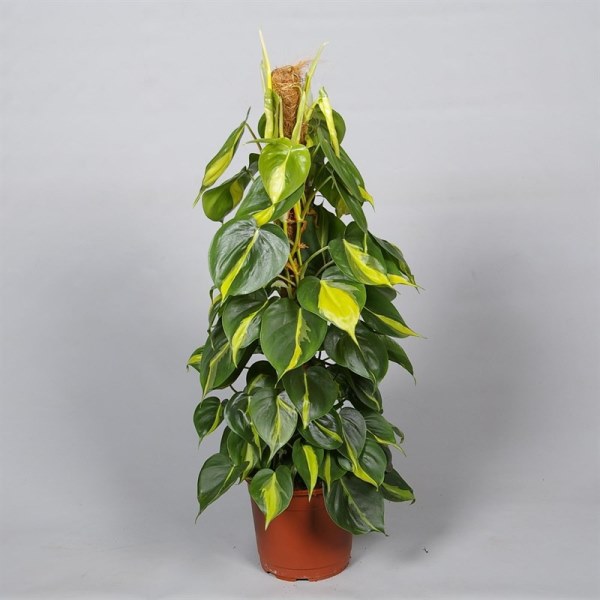
The plates of the representatives of Skandens Brazil are larger. They are also represented by a heart shape, but the edges of the leaves are more rounded. A characteristic feature of the hybrid is its coloring. It combines dark green and yellow-green shades. Light tone may appear as a narrow smear or a blurry spot. The drawing of each sheet is individual. Some gardeners manage to achieve a solid yellow-green color of individual leaves.
Blushing
Philodendron Blushing is a compact vine of unusual color. The species got its name because of the reddish hue that appears on the petioles, in the internodes, and in some varieties even on the leaves. Unlike other philodendrons, this species is practically not prone to branching. Plants are resistant to adverse environmental conditions and high viability.
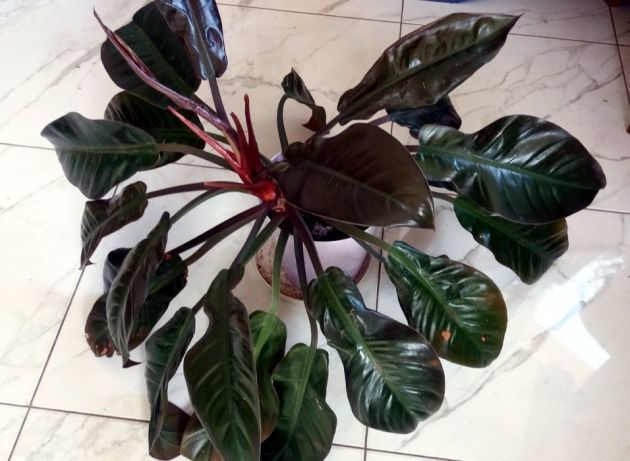
Based on the Blushing species, a mass of hybrids was bred. They vary in the color of leaf plates - from bright green to purple. Some varieties differ in marble colors of leaves.
Home philodendron care
Home care involves the creation of a microclimate that is as close as possible to the natural conditions for the plant. To avoid possible problems with cultivation, it is necessary to be guided by the advice of experienced specialists.
Soil and planting pot
The plant is grown in light soil. To prepare the substrate, you must mix the following components:
- sheet earth - 3/5;
- turf land - 1/5;
- sand - 1/5.

The pot for philodendron should pass air and moisture well. Therefore, the plant is grown in a clay or ceramic pot. The flower should not be crowded. For each transplant, a pot is taken, the volume of which is 10% higher than the previous one. There must be drainage holes at the bottom of the pot. The presence of a tray for accumulating excess moisture is mandatory.
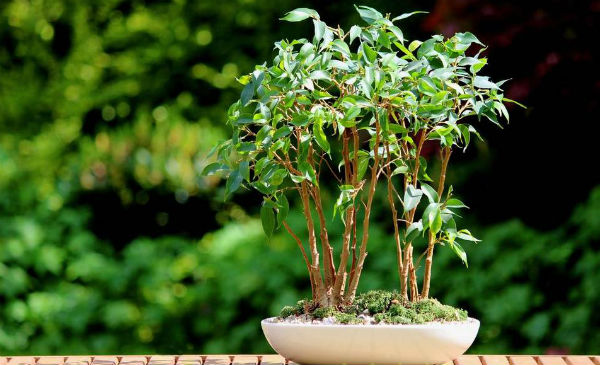 You may be interested in:
You may be interested in:Location and lighting
There is an opinion that the flower is undemanding to lighting conditions. This is not entirely true. The acute need for bright lighting is not felt only by Philodendron Brilliant and Blushing. Other species can adapt to partial shade, but experts recommend growing them in bright ambient light.
On the south side it should be placed in the back of the room, away from the window. Direct sunlight damages the flower. And the lack of light affects its appearance: the leaves are smaller, the shoot is extended, variegated species lose their decorative pattern.
Temperature
The optimal temperature regime for growing a flower is considered to be a range from + 22 ℃ to + 30 ℃. In conditions of high humidity, the plant normally tolerates a higher temperature.
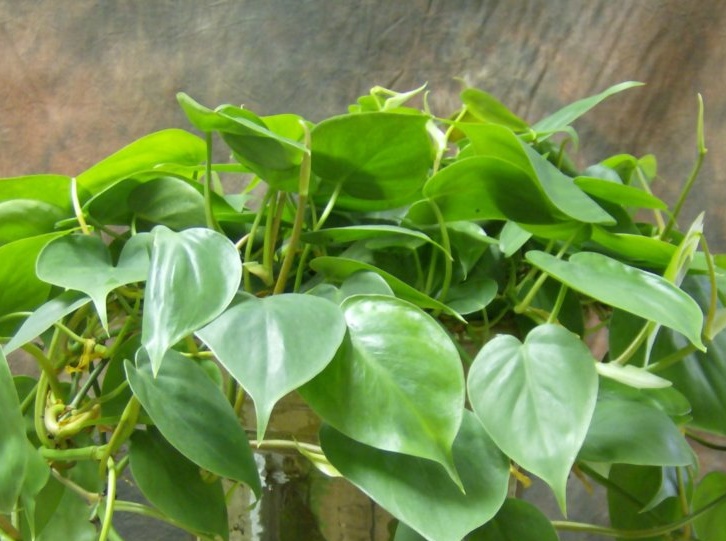
Around January, he hibernates, which continues until mid-March. At this time, it is desirable to lower the temperature to + 15 ℃. In this case, the transition should be smooth so that the flower does not feel discomfort.
Philodendron does not tolerate hypothermia, especially the Golden Black, Wrinkled and Warty appearance. The critical minimum for these species is + 18 показатель. For other plant species - + 13 ℃.
Watering and humidity
The homeland of the flower is tropical forests, therefore, it requires high humidity conditions. For this, the plant is systematically sprayed (except for the period of stagnation). It will be useful to substitute a container with wet pebbles or expanded clay under the pot.
Philodendron is often watered with plenty of water. In summer, watering is done every 2 days. In the autumn they are gradually reduced so that by winter the frequency of watering is 1 time per week. But the volume of water does not reduce, even in the dormant period, the soil should not dry out.
For irrigation use soft defended water. Before the procedure, it is brought to room temperature.
Over time, the philodendron will need support. It is advisable to purchase a special trunk made of coconut fiber with moss inside. Moisturizing the moss, you can provide the plant with additional moisture.
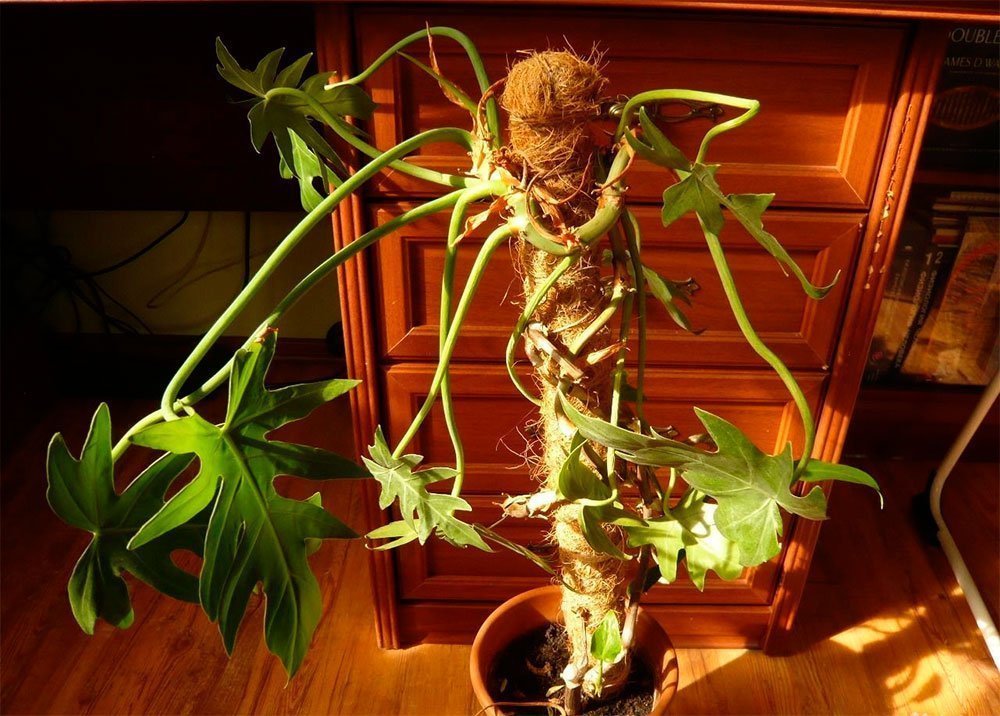
Regular hygiene procedures also contribute to increased humidity. Dust should be regularly removed from the leaves and stems of the plant with a damp cloth. Some gardeners advise periodically placing a flower under a warm shower. For the purification of velvety plates, finely dispersed atomizers are used.
Fertilizers and fertilizing
Plant nutrition is carried out in spring and summer - during the period of active growth. If the dormant period is not respected, it is permissible to fertilize the flower all year round. But in autumn and winter, the frequency of fertilizer application is halved.
Transfer
A planned transplant is carried out in the spring. Young plants should do this every year. Adult philodendrons are transplanted every 3-5 years, but each year they change the topsoil.
Unscheduled transplants are performed in such cases:
- sprouting of roots from the drainage holes of the pot;
- high concentration of salts in the soil, which is expressed by a white coating on the surface;
- strong compaction of the soil;
- moss on the surface of the substrate.
Possible problems when growing philodendron
When growing a philodendron, the grower may encounter the following difficulties:
| Problem | Cause |
|---|---|
| Drying of the tips and edges of the leaves | Low moisture, dry air or exposure to drafts. |
| Brown leaf edges | Waterlogging. |
| Small dull plates | Inadequate lighting. |
| Dry beige spots on the leaves | Sunburn. |
| Folding the sheet edge down | Excess fertilizer. |
| Yellow and small top leaves | Few fertilizers. |
| Leaf blackening | Low temperature. |
Yellowing and falling of the lower leaves is a natural process that accompanies the aging of a flower. Philodendron, like other representatives of the Aroids, is characterized by guttation - the appearance of drops of liquid on the stems.
Methods of propagation of indoor flower
There are several ways to propagate a flower. At home, philodendron can be propagated by cuttings, leaves, seeds and aerial layering.
Cuttings and leaf
The material for cuttings are apical or lateral shoots with 2-3 full leaves. Parts of a stem with aerial roots take root much faster.
Cuttings are placed in a wet mixture of sand and peat.They are kept in conditions of high humidity and high temperature until completely rooted. Then layering transplanted as adult philodendrons.
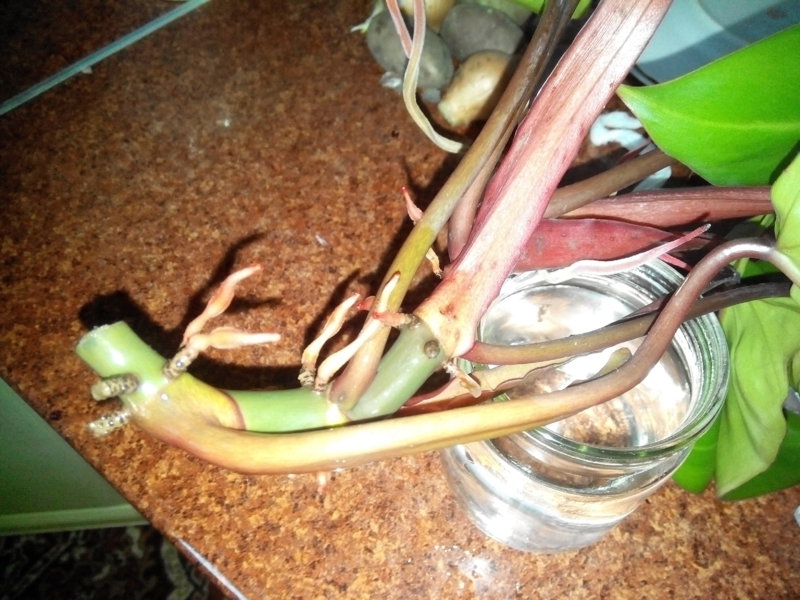
The leaf is not the most popular method of propagation, because it often rots, not having time to root. But if there is no other material for reproduction, you can try to remove the philodendron from the sheet.
Planting material is a large leaf with a heel, which is cut off in an adult, healthy plant. The rooting process is similar to the rooting of cuttings.
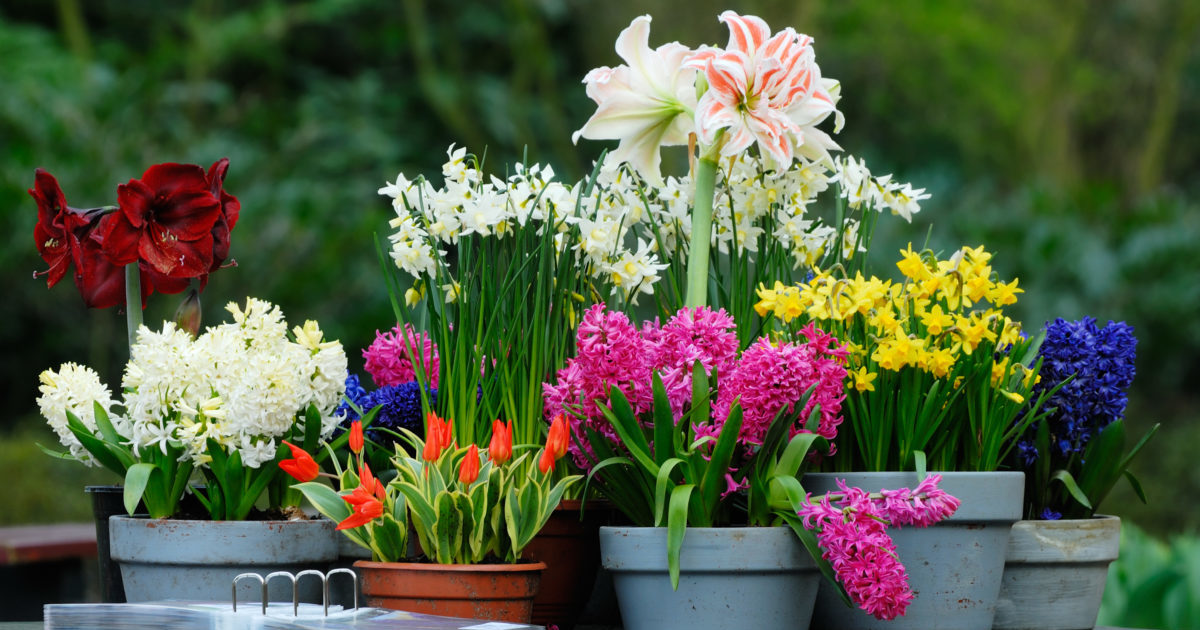 You may be interested in:
You may be interested in:Air layering
Propagation by air layering is suitable for philodendrons with vertical stems. This method is very simple and is considered the most effective.
Near the philodendron they put a flower pot filled with soil suitable for the plant. Then choose a stem, preferably with aerial roots, and root it in an additional pot. The base of the stem should remain on the mother bush, the middle is buried in the substrate, and the tip is left on the soil surface. For reliability, the stem can be pinned to the soil with a bracket.
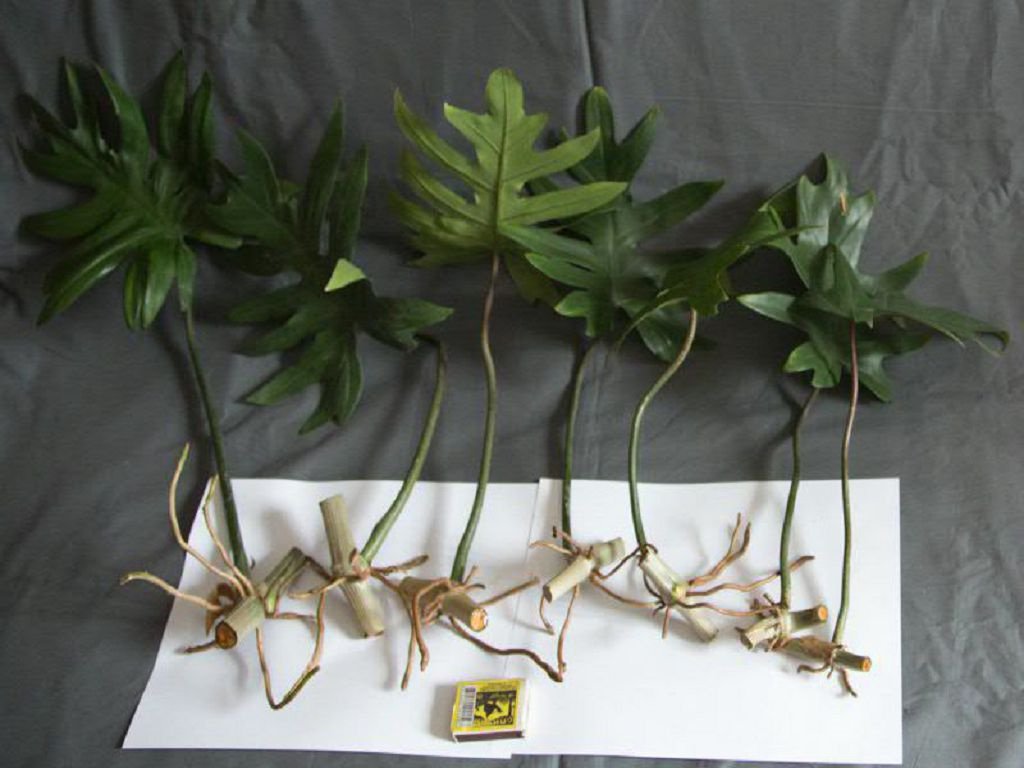
Additional care for the layering is not required, since it is powered by the main bush. When the stem is well rooted, it is cut off from the mother plant.
Seeds
Tree species of the plant are propagated by seed. Fresh seeds germinate a week after sowing. They are germinated in peaty-sandy soil, previously soaked in water for 12 hours.
For successful seedlings, seeds are germinated in greenhouse conditions: at high temperature and under glass. Planting material is not buried, but simply poured onto the soil. Daily seeds are sprayed from a finely dispersed atomizer and condensate is removed from the glass.
After hatching, the glass is removed, but flowers continue to grow under the same conditions. When the sprouts give a pair of real leaves, they are dived into separate containers. Fortified philodendrons are transplanted in the spring.
Common questions
Philodendron is a creeping houseplant used for room decor. Care for different varieties and types of this flower is different. Since the liana occupies a large space over time, this feature should be taken into account before planting.




 Sow in the ground, without seedlings: 10 beautiful and unpretentious flowers
Sow in the ground, without seedlings: 10 beautiful and unpretentious flowers Platicodon planting and outdoor care
Platicodon planting and outdoor care Hosta - planting and care in the open ground in the Urals
Hosta - planting and care in the open ground in the Urals Oleander - care and growing at home
Oleander - care and growing at home